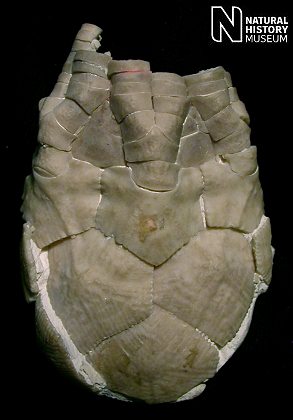 A A |
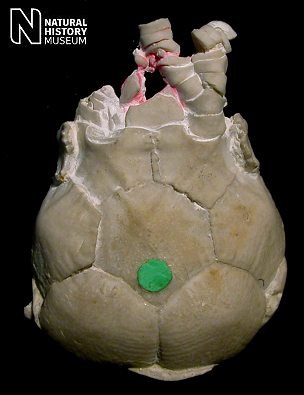 B B |
|
MARSUPITIDS |
These stemless crinoids define a zone within the latest Santonian. The characteristic polygonal plates of the calyx / cup are common within the Marsupites testudinarius zone, and although a range of ornaments occur these are all currently placed within a single species concept. Plates of the calyx are variably ribbed, grooved, smooth, or tuberculate ('knobbly'). Marsupites has a distinctive bodyplan, with a large, tall and bulbous calyx and presumably long arms. Though scarce in the field, complete and articulated remains of the calyx are disproportionately common in museum collections. This reflects a life-habit whereby the calyx rested on or was partly buried within the seafloor sediment whilst the arms were extended into the water column. The fact that even the best preserved cups retain nothing more than the very most proximal sections of the arms seems to support this. Today, articulated specimens seem to be most readily collected from the hardened chalk of the Yorkshire coast.
 A A |
 B B |
1). Marsupites testudinarius, exceptionally well preserved specimens retaining parts of the arms; (A) x1.9, Brighton, BMNH (British Museum (Natural History) London) E14261; (B) x2.6, Sussex, Mantell Collection, BMNH, E22088. Images © 2005 The Natural History Museum, by kind permission.
 A A |
 B B |
2). Marsupites testudinarius, well preserved examples; (A) x1.5; (B) x1.2; both Willett Collection, Booth Museum, (A) BMB 009678, (B) BMB 009671, by kind permission of John Cooper).
 A A |
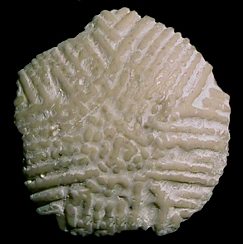 B B |
3). Marsupites testudinarius, typical smooth (A) and ornamented (B) plates of the calyx ((A) x4.0, Cissbury Ring, West Sussex, Randell Collection RR 0712; (B) x4.0, Hangleton, Highdown, near Goring-by-Sea, West Sussex, Randell Collection RR0791).
 A A |
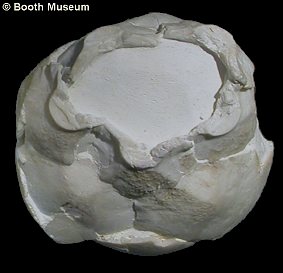 B B |
4). Marsupites testudinarius, complete cups viewed from above showing the articulating facets for the arms and the opeing which bore the tegmen (with mouth and anus) in life. Note that the plates are smooth and devoid of ornament; (A) x2.1; (B) x1.8; both in the collections of the Booth Museum, by kind permission of John Cooper).
 A A |
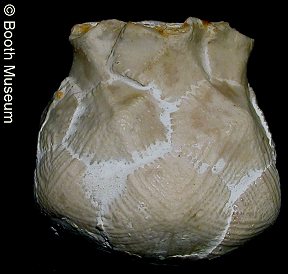 B B |
5). Marsupites testudinarius, complete cups. Compare the Knobbly ornament with the smooth ornament with the smooth cups above (Fig. 3); (A) robust adult cup, x1.7; (B) x2.3; both Willett Collection, Booth Museum, (A) BMB 007929, (B) BMB 007934, by kind permission of John Cooper).
 A A |
 B B |
6). Marsupites testudinarius; (A) Typical specimen, compare the tall, narrow nature of the calyx with the low, swollen nature of the calyx in Fig. 4 (A) above; x1.8, Peacehaven, (L. R. Strevens collection); (B) Individual retaining part of the arms, x1.8, Willett Collection, Booth Museum, BMB 009664, by kind permission of John Cooper.
 A A |
 B
B |
7). Marsupites testudinarius, details of specimens retaining parts of the arms; (A) x2.8, Brighton, BMNH (British Museum (Natural History) London) E14261, image © 2005 The Natural History Museum, by kind permission; (B) x4.1, Willett Collection, Booth Museum, BMB 009664, by kind permission of John Cooper.
 A A |
 B
B |
8). Marsupites testudinarius; What appears to be a complete calyx with associated arm elements, and the remains of a second individual (Danes Dyke, Yorkshire Coast, McIvor / Davidson Collection): (A) General view of specimen (x1.5); (B) Articulated calyx (x2.0). Images © 2010 McIvor / Davidson, used by kind permission.
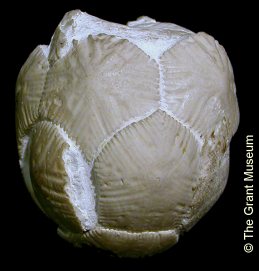 A A |
 B
B |
9). Marsupites testudinarius; (A) Incomplete calyx (x2.0, from the displays of the Grant Museum, image © 2008 The Grant Museum, by kind permission); Slightly distorted calyx, a specimen typical of the Yorkshire coast (x2.0, Yorkshire coast, Shepherd Collection, image © 2008 Roy Shepherd, used by kind permission).